What Hi-Fi? Verdict
Simple to set up, lovely to live with and supremely capable, the Sonos Arc is a soundbar of rare quality
Pros
- +
Convincing Dolby Atmos
- +
Dynamic, detailed and controlled
- +
All of the usual Sonos smarts
Cons
- -
Music could be better projected
- -
Some rivals sound weightier
- -
No HDMI pass-through ports
Why you can trust What Hi-Fi?
UPDATE: The Sonos Arc has now been discontinued and replaced by the Arc Ultra. Check out our Sonos Arc Ultra review, our guide to the best Dolby Atmos soundbars available right now, or scroll down for the original Arc review.
We could only imagine the pressure Sonos felt when it announced the Sonos Arc to the world; a follow-up to its beloved Playbar soundbar and its first new soundbar since it launched the revolutionary Beam Gen 1. However, four years on, it remains the Dolby Atmos soundbar to beat at this price.
In 2024 it is our go-to recommendation for those looking for effective Dolby Atmos sound, and a comparison device in many of our soundbar reviews. Since its launch it's only gotten better, with backup from Sonos' wider selection of smart speakers and subwoofers, meaning you can build a modular system with the Arc at the core. And with the Sonos Arc Ultra now official, the range is only getting stronger.
But we're not here to talk about those other speakers, we want to know how the Arc sounds, and if we've not already made it clear, it's a bit of a game changer.
Price
The Sonos Arc launched at a price of £799 / $799 /AU$1399 but, along with many of Sonos' other products, underwent a price increase in 2021 and now nominally retails for £899 / $899 / AU$1499. That said, discounts are fairly common – we've seen it dip below £700 / $750 / AU$1400.
The Arc replaced the Playbar and Playbase, both priced at £699 / $699 / AU$999, and originally sat above the discontinued Gen 1 Beam (£399 / $399 / AU$599). It now tops Sonos' expanded soundbar family with the virtual Dolby Atmos Beam Gen 2 priced at £449 / $450 / AU$699 and the non-Atmos Sonos Ray costing £279 / $279 / AU$399.
Rivals are plentiful, with many brands having taken aim at the Arc over the years, though none has managed to topple it. The closest rivals we've seen thus far would be Sennheiser's Ambeo Plus soundbar, albeit it's much more expensive, and Sony's HT-A7000, which did manage to snag Product of the Year in 2023 but has now increased in price compared to the Arc (and been usurped by the Sony Bravia Theatre Bar 9).
Build
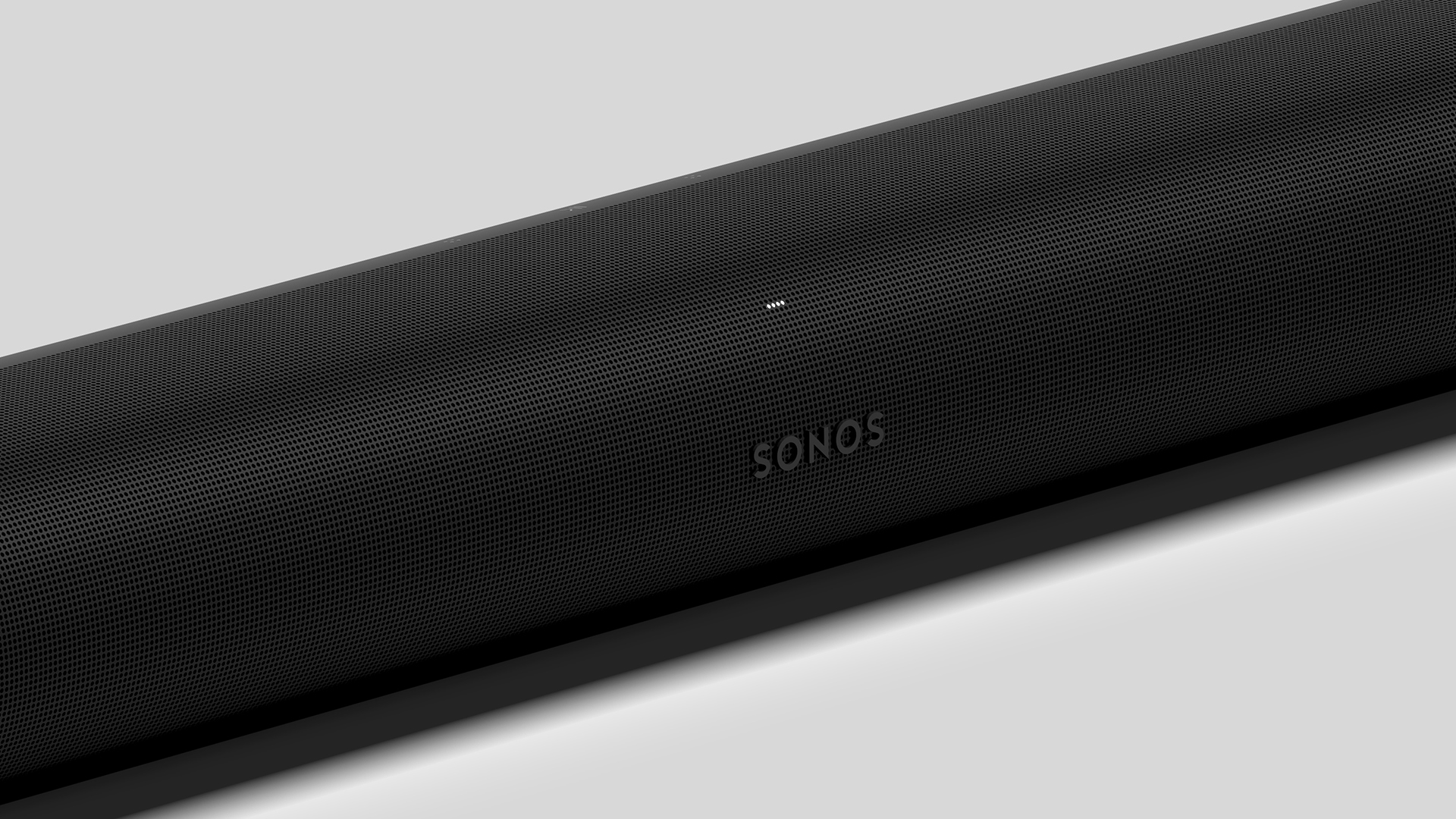
The Sonos Arc is specifically designed to partner bigger TVs than the more compact Beam Gen 2. At 114cm (45"), it is a bit wider than a typical modern 49-inch TV (remember, TVs are measured diagonally) and is proportionally best partnered with a 55-inch TV.
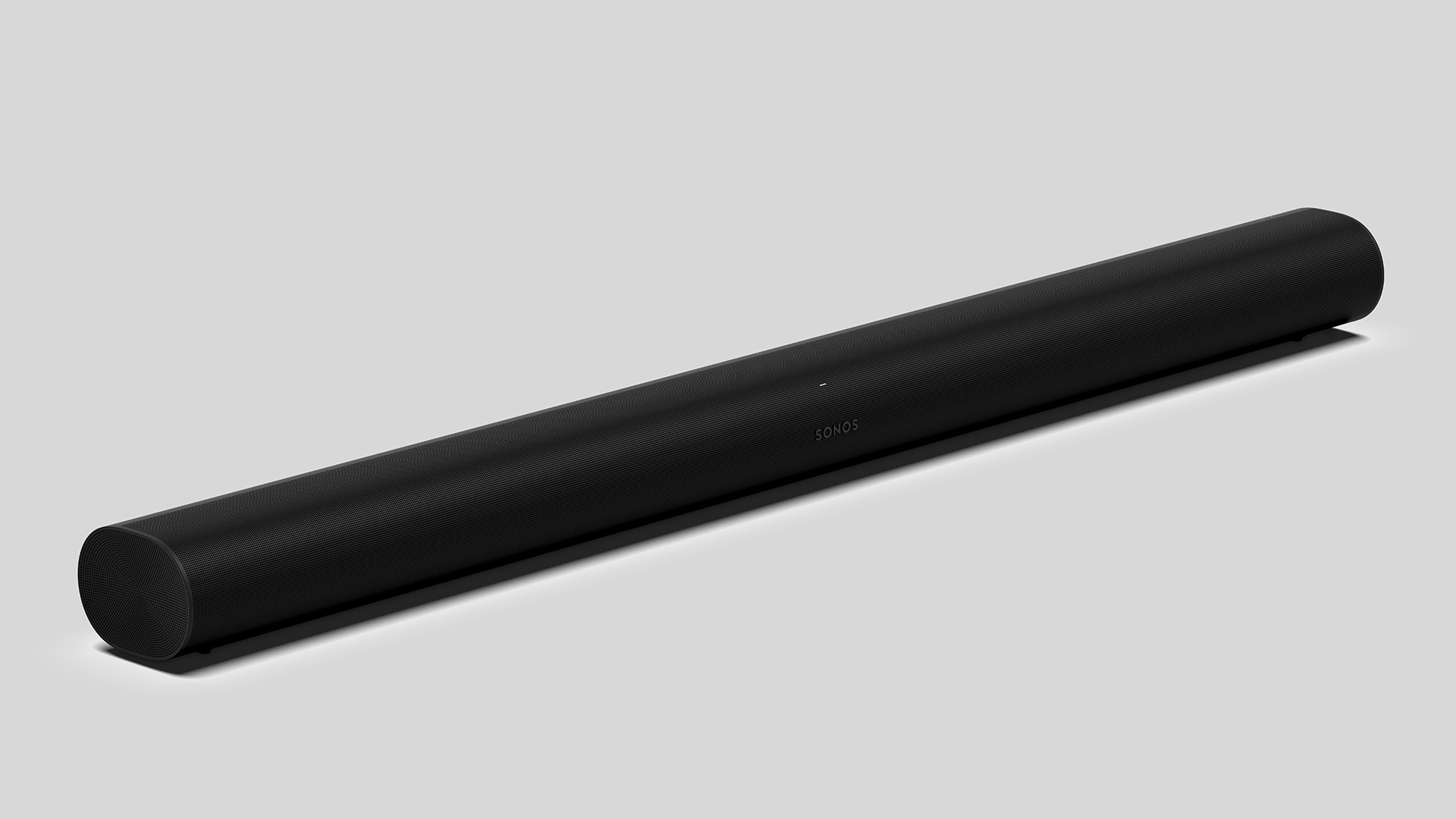
Connections HDMI, optical, ethernet
ARC/eARC eARC
Surround format support Dolby Atmos, Dolby True HD, Dolby Digital+, Dolby Digital, DTS
Bluetooth No
AirPlay 2 Yes
Voice control Amazon Alexa, Google Assistant
Dimensions (hwd) 8.7 x 114 x 12cm / 3.4 x 45 x 4.5 inches
Weight 6.3 kg / 13.8 lbs
If you don't have a sideboard big enough to accommodate its sizeable width, the Arc can be wall-mounted, with onboard Trueplay tuning software automatically adjusting the speaker's frequency response accordingly. The bespoke Sonos wall mount is a £69 / $79 / AU$99 optional extra but there are also now plenty of third-party Arc wall mounts available for less.
Once in position, most of what you can see of the Arc is a 273-degree grille that hides the array of front-mounted and up-firing speakers. Each end also features a grille-covered driver.
The curvy design helps mask the Arc’s dimensions and makes it look svelte, but its height measurement of 8.5cm is not inconsiderable. That's unlikely to be so high as to encroach on your TV's picture, but it could conceivably block the signals being sent to it by your remote control. At least it could were it not for the integrated IR repeater, which is enabled by default and works flawlessly during testing.
The Arc's own status light consists of LEDs that shine through four holes above the subtle Sonos logo (fun fact: there are 76,000 holes in all the grilles combined). By default, these LEDs remain off most of the time and their brightness is tailored to the ambient light in the room even when they are lit (when adjusting volume, for example), so as not to appear too bright.
The touch-sensitive play/pause 'button' is integrated into the frame and flanked by two context-sensitive touch panels that you can use to control volume, if you use them at all. To the right are the microphone button and a single LED that indicates whether the Arc is listening for Alexa or Google Assistant voice commands.
Features
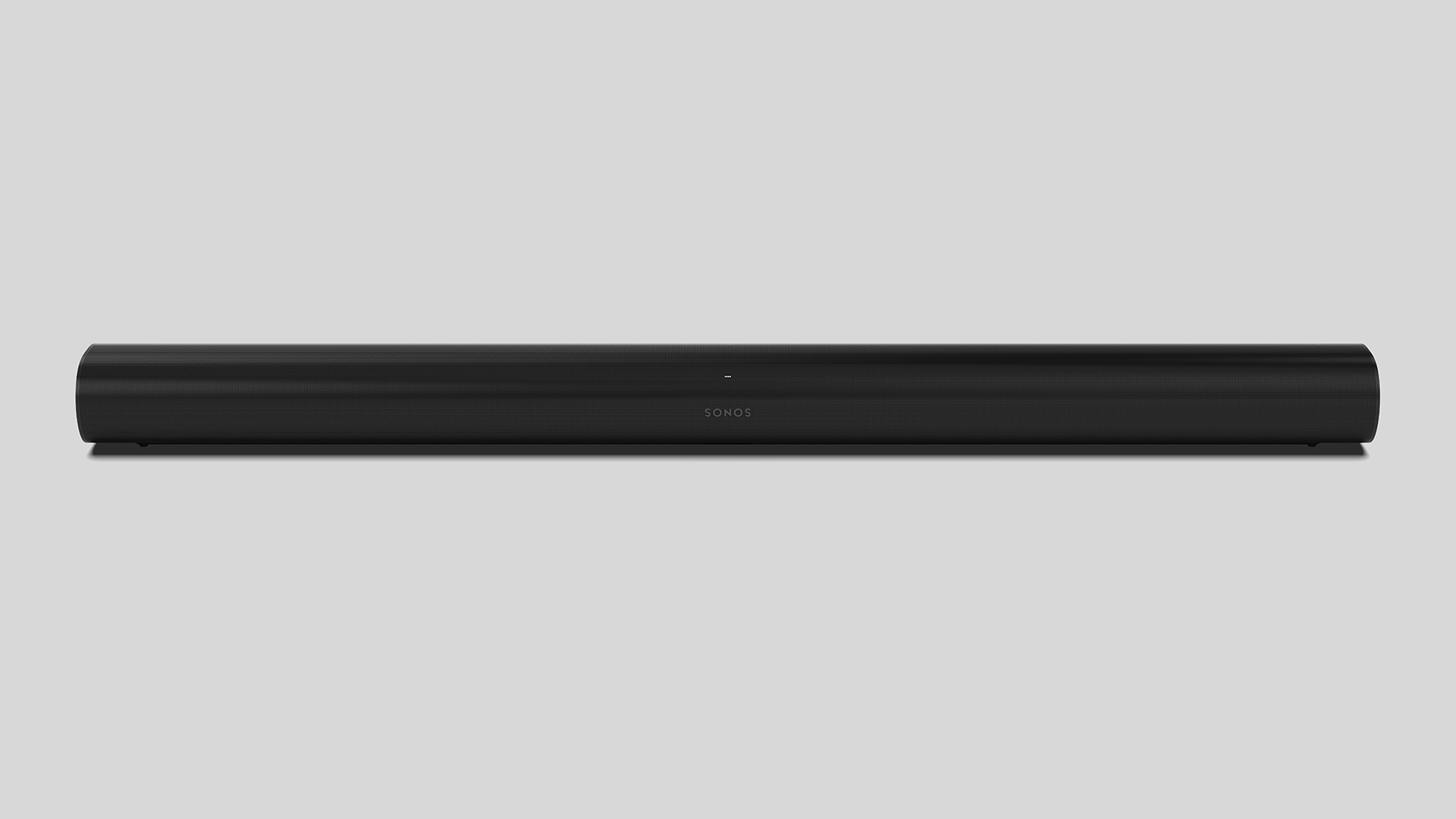
At the back of the Arc are the power socket, an ethernet connection for wired networking, and a single HDMI port. An optical adapter is included for those with older TVs, but the intention is that you use HDMI and the ARC (Audio Return Channel) functionality to get the sound from your TV to the Arc.
In fact, unlike the original Beam and the Ray, the Arc supports eARC (Enhanced Audio Return Channel), so it can handle higher-quality Dolby Atmos signals from TVs that can output them. Sonos notes that there are now over 25 streaming apps that carry content in Dolby Atmos (Netflix, Amazon Prime Video, Disney+ and Apple TV, to name just four), so it's becoming increasingly widespread.
It’s important to note that eARC isn’t essential for Dolby Atmos transmission. Atmos can be carried using either the Dolby Digital+ format or the higher-quality Dolby True HD. A standard ARC connection can handle the former but not the latter. Currently, all streaming services use Dolby Digital+ for their Atmos soundtracks anyway, so eARC holds no advantage here, but it does enable higher bit rate Atmos sound to be passed from an external source, such as a 4K Blu-ray player or Xbox, through the TV and on to the Arc.
Of course, your TV’s specs are important here. To get True HD Dolby Atmos, your TV needs to not only support eARC but also have pass-through functionality. And just because your TV has eARC or ARC doesn’t mean every one of its streaming apps that should carry Atmos actually will.
We've now tested the Arc with many of the best TVs, and it's clear that mileage varies based on brand and age. The Now Playing screen in the Sonos app flags up that Dolby Atmos is being received, while the About My System part of the settings menus confirms the format in which it’s being transmitted. With a bit of fiddling in the TV menus, all of the LG OLED and Samsung QLED TVs that we've used have been able to transmit Dolby Atmos to the Arc from their integrated apps and pass through True HD Atmos from our Oppo UDP-203 Blu-ray player without issue.
However, the older Samsung Q7F that we still have knocking around, which doesn’t have eARC but does have ARC, doesn't support Atmos, either from its apps or an external source. In short, the newer your TV, the better its Atmos support is likely to be. Of course, this wouldn’t be an issue if the Arc had more HDMI inputs that allowed it to take audio directly from an external source and not rely on your TV as a go-between, but the downside to that would be a much less simple, less neat set-up.
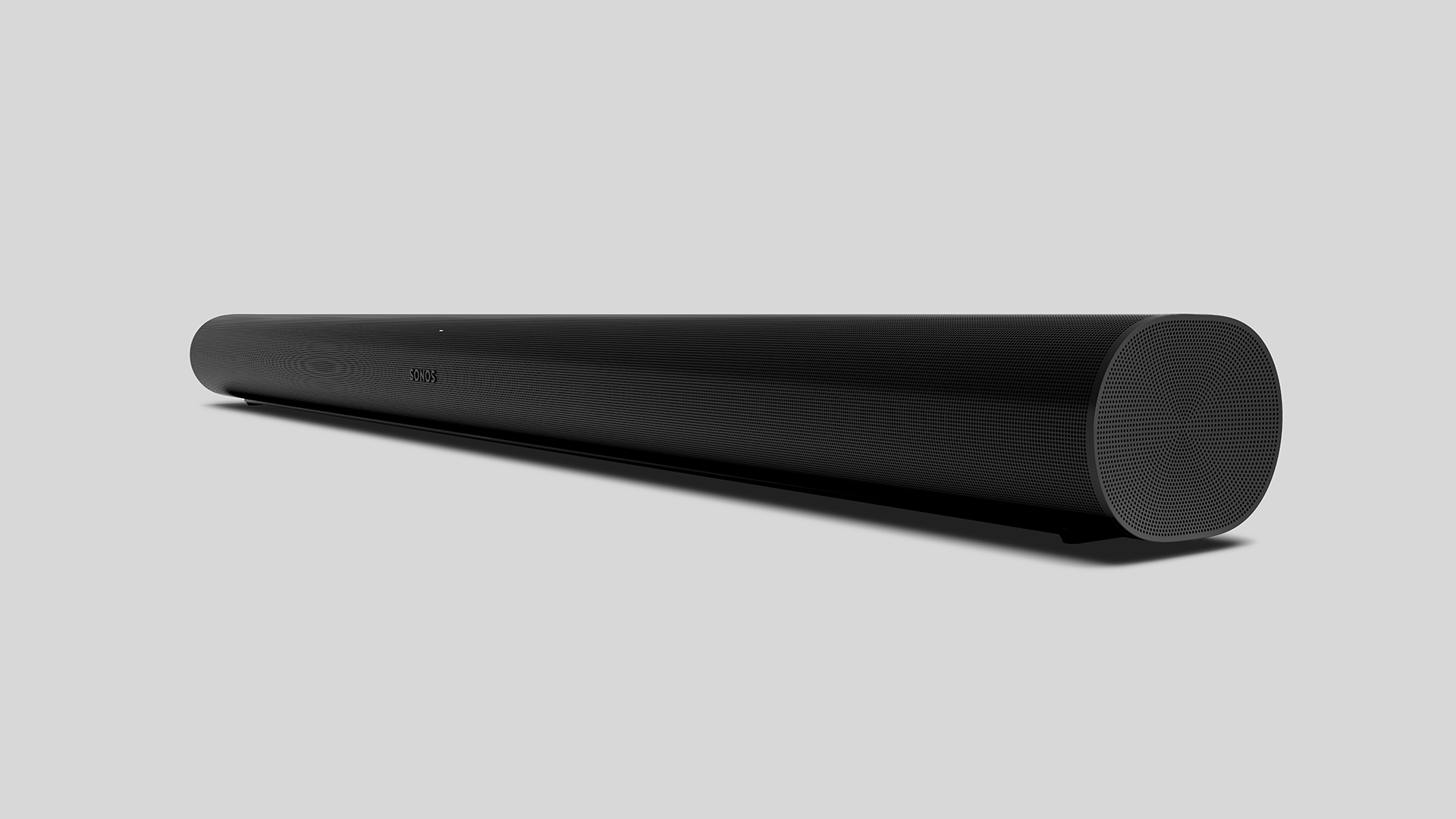
The Arc's Dolby Atmos sound field is generated by 11 Class D digital amplifiers that power 11 custom drivers. Eight of those drivers are elliptical woofers evolved from those in the Beam (four along the front, two on top and one in each end), while the other three are silk-domed tweeters that are all built into the front but with two firing diagonally into the room.
Sonos refers to the Arc's arrangement as 5.0.2, which clearly doesn't add up to 11 but makes more sense if you think of it as using its 11 drivers to attempt to replicate the soundfield of a five-channel surround sound system with no subwoofer and two height speakers. That '0' can be turned into a '1' through the addition of a Sub Gen 3 priced at £699 / $699 / AU$999 or new Sub Mini (£429 / $429 / AU$699). Other Sonos speakers can be used as dedicated surrounds, such as two Sonos One and One SL rear speakers costing £358 / $358 / AU$538 or the Symfonisk bookshelf speakers priced at £99 / $99 (around AU$176) from Sonos' IKEA collaboration. There are also now new Era speakers, the more expensive of which, the Era 300 (£449 / $449 / AU$749), has up-firing speakers so can complete the Arc's Dolby Atmos presentation in a way that previously wasn't possible. The cheaper Era 100 will still provide top-notch surround sound, but it doesn't include dedicated upward-firing drivers for Dolby Atmos like the 300.
The Arc uses its array of speakers to bounce sound off your walls and ceiling to create a 3D audio effect, and the soundfield is once again tailored to your room using Sonos' Trueplay technology. Despite the extra audio plane, the process is identical to that of other Sonos speakers: the soundbar outputs a series of test sounds that are measured by your iOS device (Android devices still aren't supported), first from the listening position and then from around the room.
Bass and treble can also be adjusted in the Sonos app, although you're unlikely to feel the need, and the Loudness function can be disabled here, too. There's also a Night Sound feature that flattens dynamics and reduces bass, ideal for when you don't want to wake the rest of the household, while Speech Enhancement aims to project dialogue more clearly.
The Arc runs exclusively on the new Sonos S2 platform, which launched in June 2020. All your other Sonos devices will need to be updated to S2 in order to work with the Arc, and it's worth remembering that some older Sonos devices are entirely incompatible with the new software.
It's easy to play music through the Arc without touching the Sonos app at all. Just like its siblings, it appears as a playback device in the Spotify and Tidal phone apps, and AirPlay 2 allows for almost any audio to be sent to it from an iOS device. It can also be controlled via Alexa and Google Assistant, with the four far-field microphones spaced along the chassis able to pick up your commands, even when music or a movie is blasting out.
The Arc can also talk to your TV using HDMI-CEC, meaning that it will turn on and switch to TV audio when you turn on your television. You can also increase or decrease the Arc's volume using your TV's remote, and you can turn your TV on using voice commands aimed at the Arc. Add an Amazon Fire TV device or Google Chromecast to your system (plugged into one of your TV's HDMI sockets) and you can even use the Arc to access specific content using only your voice.
Sound
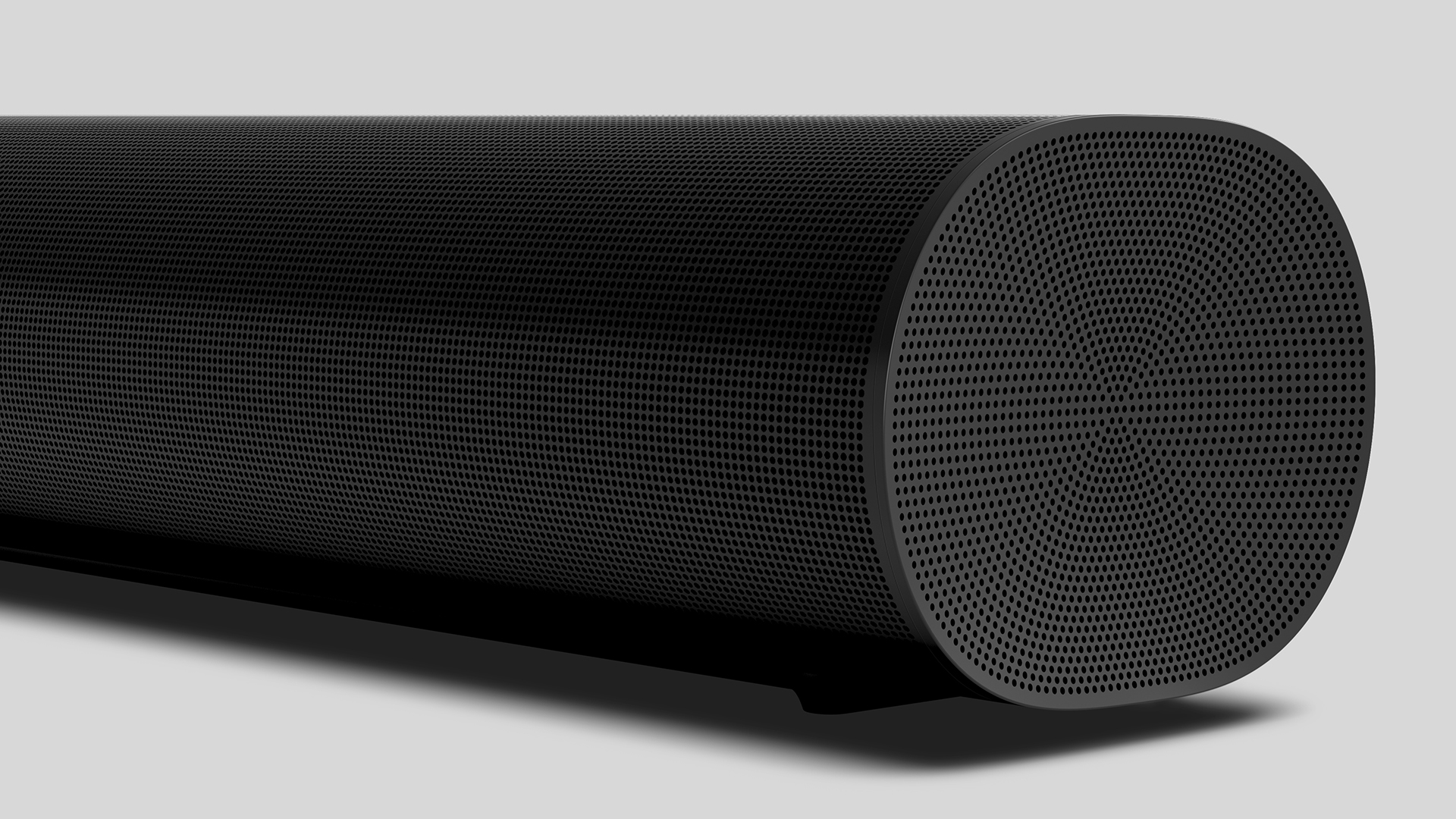
With Dolby seemingly licensing the Atmos badge to anyone willing to pay the fee, it’s little guarantee of quality, as anyone who’s listened to the tiny speakers of an Atmos-badged phone or even most Atmos-badged TVs will attest.
Even the majority of soundbars with upward-firing speakers struggle to deliver a convincing Atmos experience. Often, the mistake is thinking that Dolby Atmos is simply about adding height to a soundtrack, when it should be about filling the room with sound and precisely placing effects in a three-dimensional soundstage.
Thankfully, Sonos has taken the addition of Atmos to its line-up seriously. “It’s so much more than just pointing a couple of speakers upwards,” says Sonos’s product manager Scott Fink. “For Arc, we focused on the playback precision of all the channels, including the height channels.”
According to Fink, Sonos put much work into iterating the curvature of the internal waveguides, revamping Trueplay to account for ceiling distance, angles and acoustics, and tuning Arc with Atmos content producers in music, movies and TV.
All of that effort paid off: the Sonos Arc delivers one of the most convincing Atmos presentations of any soundbar we’ve heard. Height junkies can turn up the volume of the Arc's upward-firing drivers using a separate control, but we don't find it necessary to overly boost the vertical channel to enjoy the Arc's immersive delivery.
Playing the bombing run scene from Unbroken and we’re immediately transported to within the fuselage of the B-24 Liberator. Our listening room is filled with wind noise and the whirr of the plane’s engines, and the incidental creaks and rattles are placed in specific spots, including right in the top corners of the wall we’re sitting against.
Those incidental details are lovely, but the Arc is dynamically deft too, and it’s this combination of qualities that makes the performance so evocative. Each part of the plane sounds different – areas open to the elements are airy and cacophonous, while others are more enclosed and keep outside noise more muffled. As the camera switches between positions, the Arc conveys the subtly unique volume and texture of each.
Bigger dynamic shifts are also handled with aplomb, with the first fly-by of the Japanese fighter plane and the machine-gun fire from the Liberator’s emplacement rocking the room, even at less than a quarter of the Arc’s volume.
We switch to Blade Runner 2049 and this dynamism impresses us further. The scene in which K and Joi fly out of Los Angeles and towards the orphanage transitions from loud – as waves hit the flood barrier – to eerily quiet, as the rain hits the car, with occasional bits of clearly projected dialogue.
As the storm batters the car, low, distant rumbles of thunder become a more constant barrage from the sky. The bullets fired from below streak across the room, the music builds again, with more menace this time. Suddenly, a spark of lightning plunges everything into near silence as all power is lost and all that is left is the sound of the rain. These sonic contrasts are all handled elegantly, ensuring every dramatic point is delivered.

Reinforcing those loud effects and the Hans Zimmer-composed, Vangelis-like soundtrack is a supremely well judged bass performance. There are vast quantities of deep, weighty and tuneful bass, but the lower frequencies never overwhelm and even at its loudest and deepest, the Arc remains remarkably composed. While its low end isn't the most weighty we've heard, there is no necessity to add a Sub unless you really want that cinematic rumble only large drivers can deliver. The treble is clean and sparkly, without veering into harsh brightness, and so clearly projected is dialogue that, even in the most mumbly of dramas, we never feel the need to enable the Speech Enhancement feature.
That tonal evenness helps make the Arc a much more musical performer than most soundbars. Playing SBTRKT’s Trials Of The Past via Tidal, the treble is crisp but not distracting, the synthesised bass notes have a solid initial thump and smooth fade, and the vocal is clear in the middle, even as the track gets busy. The sibilance isn’t highlighted here as it can be from other sound systems, either.
Switching to Radiohead’s 15 step, there’s effective spatial and rhythmic organisation of the challenging arrangement, with each instrument given space in which to breathe and each making sense even during the track's busiest moments.
Our only complaint about the musical performance is that sound isn’t projected forward and towards the listening position as much as you’d expect, given that movie soundtracks are delivered with such three-dimensionality.
Sonos uses all of the Arc’s drivers during stereo playback, and it might be that the upward- and side-firing speakers are doing too much. Switching the bias to the front-firing drivers might result in a more direct and engaging delivery, and perhaps this is something that Sonos could address in a future software update.
Verdict
That slight lack of directness to music and modest, though well-controlled, bass are our only criticisms of the Arc. It is a stunning performer, delivering one of the most immersive Dolby Atmos experiences we’ve heard from a soundbar. And while the Sony HT-A7000 would perhaps pip it for pure performance, it's now noticeably more expensive than the Arc.
The Arc is more than a soundbar, too. It’s also an app- or voice-controlled wireless speaker with access to practically every music streaming service, and it can be combined with other Sonos speakers in order to create a more complete surround sound arrangement or a multi-room system.
Rarely does a device arrive that does so much and does it all so well. Even rarer that it remains a class leader almost three years after release. Be in no doubt; the Sonos Arc is a superb bit of kit.
First reviewed: June 2020. Updated review: November 2024.
SCORES
- Sound 5
- Features 4
- Build 5
MORE:
5 mistakes everyone makes with Sonos' Dolby Atmos soundbars
32 Sonos tips, tricks and features
22 of the best Dolby Atmos movie scenes that put your soundbar to the test
What Hi-Fi?, founded in 1976, is the world's leading independent guide to buying and owning hi-fi and home entertainment products. Our comprehensive tests help you buy the very best for your money, with our advice sections giving you step-by-step information on how to get even more from your music and movies. Everything is tested by our dedicated team of in-house reviewers in our custom-built test rooms in London, Reading and Bath. Our coveted five-star rating and Awards are recognised all over the world as the ultimate seal of approval, so you can buy with absolute confidence.
-
Hifiman2007 What. I purchased this for a second room. Its £800 and I'm afraid is absolutely useless at Atmos. I have a separates based Atmos system in my main room. This is almost just a fake stab reliant on height of ceiling etc..I think the review needs to be clear it's no match for a proper Atmos set up and actually poor value taking that into account £800 can buy a complete Atmos receiver and Speaker package that simply blows this away.Reply -
bravewolverine Out of interest, what settings did you have to tweak on the LG C9 to get Atmos passed through from the integrated apps? Arc arrives next week and would be good to know what settings to tweak (assume it is sound coming from HDMI Arc and changing to passthrough for sound rather than auto?)Reply -
Tarx Reply
You must be one of the very first to have this speaker if you have it and reviewed it already. Can we see a picture of how you’re set it up?Hifiman2007 said:What. I purchased this for a second room. Its £800 and I'm afraid is absolutely useless at Atmos. I have a separates based Atmos system in my main room. This is almost just a fake stab reliant on height of ceiling etc..I think the review needs to be clear it's no match for a proper Atmos set up and actually poor value taking that into account £800 can buy a complete Atmos receiver and Speaker package that simply blows this away. -
sevengroove Reply
Was the Arc mounted or on a TV stand for this review? My TV stand is about 18" tall, and I'm curious to know if I will experience any significant gain in audio quality if I mount the bar between 30 - 36", which is roughly head height when I'm on the couch.What Hi-Fi? said:Sonos might be late to the party, but its first Dolby Atmos soundbar is an absolute belter.
Sonos Arc : Read more
Edit for more context: I have a 65" LG C9 currently sitting on the TV stand which will be mounted as well to accommodate the Arc. So I'm trying to decide if I should just mount the Arc along with the TV or save the $80 and let the Arc sit on the stand. -
Hifiman2007 Reply
Hello.Tarx said:You must be one of the very first to have this speaker if you have it and reviewed it already. Can we see a picture of how you’re set it up?
To clarify. I ordered this product for delivery and was told 10 June was delivery date. This was from a well known on line retailer(who offered a 6 year gtee) same retailer emailed me and explained product was in stock but due to current issues could not deliver on 10th however it could be delivered prior to that date. Guess what I said yes. I'm unsure Sonos were aware.
I have not in my review said this product is bad. It's not it's good. It's just not as what hifi seem to allude to a proper Atmos product. Sorry but it's a fact. I have not mentioned other brands as I have no interest or anything to gain I'm just tempering expectations.
As for a picture of my set up..I don't post pictures on social media of my home and won't here. Why should I. I hope this answers your questions.
Hifiman2007 said:What. I purchased this for a second room. Its £800 and I'm afraid is absolutely useless at Atmos. I have a separates based Atmos system in my main room. This is almost just a fake stab reliant on height of ceiling etc..I think the review needs to be clear it's no match for a proper Atmos set up and actually poor value taking that into account £800 can buy a complete Atmos receiver and Speaker package that simply blows this away.
HelloTarx said:You must be one of the very first to have this speaker if you have it and reviewed it already. Can we see a picture of how you’re set it up?
To clarify this product was ordered from a well known online retailer for delivery 10 June. The same retailer emailed me and said product was in stock and due to current issues could not deliver all orders due for delivery on 10th June...however could deliver earlier. Guess what I agreed I'm unsure Sonos were aware they were doing this. My review does not say this is a bad product. Rather it's not a convincing Atmos product compared to a proper set up (ask what hifi for there opinion on this) a self contained soundbar cannot physically provide object based sound(in my opinion). Never seen an Atmos cinema with a soundbar.
I will not post a picture of my set up(s) I don't and won't post pictures of home on social media. Isnt it a burglary invitation?
I hope this answers ure queries. -
DaviWils Reply
Clearly telling lies, since it isn't even released yet LOLHifiman2007 said:What. I purchased this for a second room. Its £800 and I'm afraid is absolutely useless at Atmos. I have a separates based Atmos system in my main room. This is almost just a fake stab reliant on height of ceiling etc..I think the review needs to be clear it's no match for a proper Atmos set up and actually poor value taking that into account £800 can buy a complete Atmos receiver and Speaker package that simply blows this away. -
Hifiman2007 Reply
Products are delivered to store warehousing in advance of release date. It's very common for customers to receive products before release date. How do u think so many sites have already reviewed the product. If a retailer cannot fulfill all orders placed to be received on release day it may attempt to re arrange. Clearly at moment it is reduced delivery capacity..and so will utilise any spare capacity to get a product to a customer either on. Before or as soon after release date. Next time you see a q outside the Apple store check online how many people have already received the product prior to that date. Never seen a movie at flix prior to its official release date? What gain have I got with my comments. I've not offered advice on an alternative brand product. Just left an honest opinion. Incidentally many other reviews are saying it offers little in height channels which is what I eluded to and also one of the main purposes of an ATMOS soundtrack.DaviWils said:Clearly telling lies, since it isn't even released yet LOL -
DaviWils Reply
Whatever. Some people are not interested in installing a full wired ceiling solution and just want a really good quality soundbar, for those people, this looks like a good bet.Hifiman2007 said:Products are delivered to store warehousing in advance of release date. It's very common for customers to receive products before release date. How do u think so many sites have already reviewed the product. If a retailer cannot fulfill all orders placed to be received on release day it may attempt to re arrange. Clearly at moment it is reduced delivery capacity..and so will utilise any spare capacity to get a product to a customer either on. Before or as soon after release date. Next time you see a q outside the Apple store check online how many people have already received the product prior to that date. Never seen a movie at flix prior to its official release date? What gain have I got with my comments. I've not offered advice on an alternative brand product. Just left an honest opinion. Incidentally many other reviews are saying it offers little in height channels which is what I eluded to and also one of the main purposes of an ATMOS soundtrack. -
Hifiman2007 Another 5 star review today. Yet even this review summary is exactly all I have said.Reply -
no-name-123 With out genuine pictures, we can't trust the text as genuine. Burglars would need to identify the out side of the house, and be sure your user name was the real you. With good reason I use a pen name. Just obstruct the windows when pictures are takenReply


